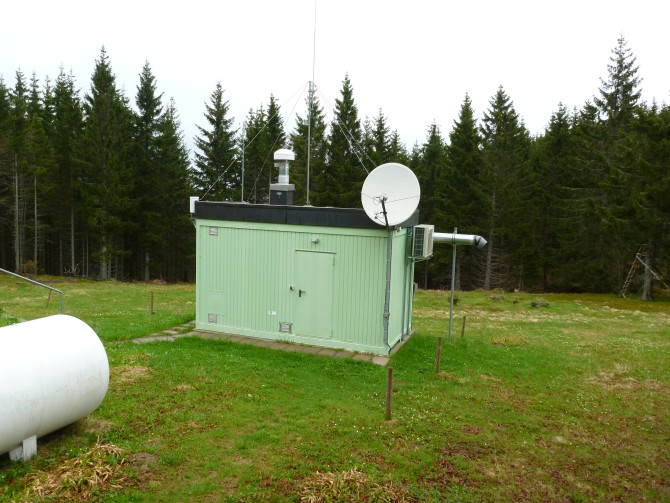At the center the Earth is a solid metal ball, a kind of “planet within a planet,” whose existence makes life on the surface possible, at least as we know it.
How Earth’s inner core formed, grew and evolved over time remains a mystery, one that a team of researchers is seeking to plumb with the help of seismic waves from naturally occurring earthquakes. While this 2,442-kilometer-diameter sphere comprises less than 1% of the Earth’s total volume, its existence is responsible for the planet’s magnetic field, without which Earth would be a much different place.
The inner core is not the homogenous mass that was once assumed by scientists, but rather it’s more like a tapestry of different “fabric,” according to Guanning Pang, a postdoctoral researcher in the Department of Earth and Atmospheric Science at Cornell Engineering. “For the first time we confirmed that this kind of inhomogeneity is everywhere inside the inner core,” said Pang, who is the lead author of a new study published July 5 in Nature that opens a window into the deepest reaches of Earth. He conducted the research as part of his Ph.D. dissertation at the University of Utah.
The other final frontier
“What our study was about was trying to look inside the inner core,” said University of Utah seismologist Keith Koper, who oversaw the study. “It’s like a frontier area. Anytime you want to image the interior of something, you have to strip away the shallow effects. So this is the hardest place to make images, the deepest part, and there’s still things that are unknown about it.”
Commission for the Comprehensive Nuclear-Test-Ban Treaty Organization radionuclid station on mountain Schauinsland in Germany.
This research harnessed a special dataset generated by a global network of seismic arrays set up to detect nuclear blasts. In 1996, the United Nations established the Preparatory Commission for the Comprehensive Nuclear-Test-Ban Treaty Organization, CTBTO, to ensure compliance with the international treaty that bans such explosions.
Its centerpiece is the International Monitoring System, featuring four systems for detecting explosions using advanced sensing instruments sited all over the world. While their purpose is to enforce an international ban on nuclear detonations, they have yielded troves of data scientists can use to shed new light on what’s going on in Earth’s interior, oceans and atmosphere.
This data has facilitated research that illuminated meteor blasts, identified a colony of pygmy blue whales, advanced weather prediction, and provided insights into how icebergs form.
While Earth’s surface has been thoroughly mapped and characterized, its interior is much harder to study since it cannot be directly accessed. The best tools for sensing this hidden realm are earthquakes’ seismic waves propagating from the planet’s thin crust and vibrating through its rocky mantle and metallic core.
“The planet formed from asteroids that were sort of accreting [in space]. They’re running into each other and you generate a lot of energy. So the whole planet, when it’s forming up, is melting,” Koper said. “It’s simply that the iron is heavier and you get what we call core formation. The metals sink to the middle, and the liquid rock is outside, and then it essentially freezes over time. The reason all the metals are down there is because they’re heavier than the rocks.”
Planet within a planet
For the past few years, Koper’s lab has been analyzing seismic data sensitive to the inner core. A previous study, led by Pang, identified variations between the rotations of Earth and its inner core that may have triggered a shift in the length of the day in 2001 to 2003.
Earth’s core, which measures about 4,300 miles across, is comprised mostly of iron and some nickel, along with a few other elements. The outer core remains liquid, enveloping the solid inner core.
The Seismograph Stations housed on the University of Utah campus record earth movements.
“It’s like a planet within a planet that has its own rotation and it’s decoupled by this big ocean of molten iron,” said Koper, a geology professor who directs the University of Utah Seismograph Stations.
The protective field of magnetic energy surrounding Earth is created by convection occurring within the liquid outer core, which extends 2,260 kilometers (1,795 miles) above the solid core, he said. The molten metal rises above the solid inner core, cools as it approaches Earth’s rocky mantle and sinks. This circulation generates the bands of electrons enveloping the planet. Without Earth’s solid inner core, this field would be much weaker and the planetary surface would be bombarded with radiation and solar winds that would strip away the atmosphere and render the surface uninhabitable.
For the new study, the Pang and Koper looked at seismic data recorded by 20 arrays of seismometers placed around the world including two in Antarctica. The closest to Utah is outside Pinedale, Wyo. These instruments are inserted in boreholes drilled up to 10 meters into granite formations and arranged in patterns to concentrate the signals they receive, similar to the way parabolic antennae work.
Pang analyzed seismic waves from 2,455 earthquakes, all exceeding magnitude 5.7. The way these waves bounced off the inner core help map its internal structure. Smaller quakes do not generate waves strong enough to be useful for the study.
“This signal that comes back from the inner core is really tiny. The size is about on the order of a nanometer,” Koper said. “What we’re doing is looking for a needle in a haystack. So these baby echoes and reflections are very hard to see.”
The core is changing
Scientists first used seismic waves to determine that the inner core was solid in 1936. Before the discovery by Danish seismologist Inge Lehmann, it was assumed the entire core was liquid since it is exceedingly hot, approaching 10,000 degrees Fahrenheit, about the temperature on the sun’s surface.
At some point in Earth’s history, the inner core started “nucleating,” or solidifying, under the intense pressures existing at the center of the planet. It remains unknown when that process began, but the U team gleaned important clues from the seismic data, which revealed a scattering effect associated with waves that penetrated to the core’s interior.
“Our biggest discovery is the inhomogeneity tends to be stronger when you get deeper. Toward the center of the Earth it tends to be stronger,” Pang said.
“We think that this fabric is related to how fast the inner core was growing. A long time ago the inner core grew really fast. It reached an equilibrium, and then it started to grow much more slowly,” Koper said. “Not all of the iron became solid, so some liquid iron could be trapped inside.”
Participating in the study, which was funded by the National Science Foundation, were researchers from University of Southern California, the Université de Nantes in France, and the Los Alamos National Laboratory.
This article was adapted from a version written by Brian Maffly with permission from the University of Utah.








